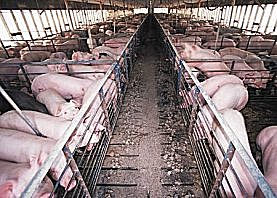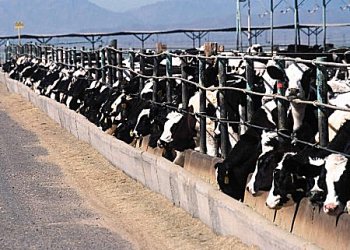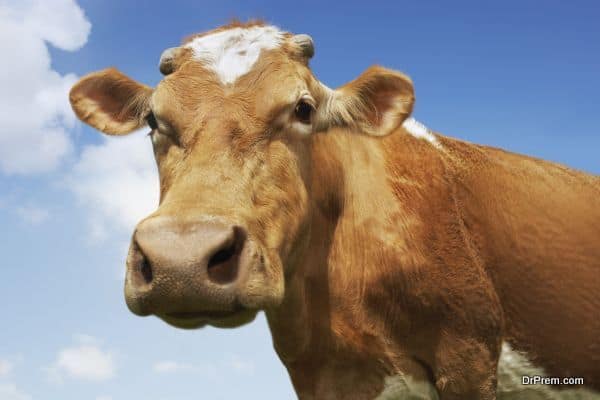Since the 1980s, livestock farming in the USA has become highly specialised. Individual farms often conduct only particular functions in the process of animal production. One function in this factory style farming is the housing and feeding of cattle and poultry. According to the U.S. Environmental Protection Agency (EPA), 500 million tons of manure was generated by the nation’s 238,000 feeding operations in the year 2003. Of these a very small percentage of facilities described as Concentrated Animal Feeding Operations (CAFOs) alone accounted for over half of this waste.

Hogs on a Factory Farm
Needless to say, CAFOs are the backbone of big livestock farms and it has been estimated that today there are around 19,000 such units across the United States. So what exactly are they? CAFOs are agricultural facilities that house and feed a large number of animals. Any single facility is considered a CAFO if it conducts this operation for over 45 days in a single year. According to US Federal regulations a CAFOs must have a permit and develop detailed nutrient-management plans to ensure that animal waste does not run off into local water bodies and pollute them.
Since the 1970’s CAFOs have been regulated by the EPA and like all agricultural operations that are also governed by the Clean Air and Clean Water Acts as well as State and Federal Environmental Laws. Nevertheless, animal waste and manure from large U.S. livestock farms causes environmental pollution and has been identified as a health hazard has once again become the focus for an angry debate. The moot question being raised is: should farmers and ranchers be held responsible for cleaning up the mess resulting from their operations?

Feeding Stalls for Cattle
This latest debate to hit the headlines soon after Oklahoma Attorney General Drew Edmondson filed a lawsuit against Arkansas poultry companies. The suit alleges that phosphorus runoff from chicken litter is contaminating water bodies in Oklahoma. Tyson Foods Inc., a Springdale, Arkansas based meat company appears to be at the centre of this suit.

Industrial Chicken Coop
Speaking to the Senate Committee on Environment and Public Works on 6th September, Edmondson noted that:
States like Oklahoma need legal tools to help stop and clean up animal-waste contamination, which is destroying significant and irreplaceable public resources.
This action has been supported by Benjamin Grumbles, an assistant administrator for water with the EPA who said that individual states do
have the right to sue
as they are responsible for programs supervised by the EPA.
Indeed bipartisan legislation introduced in the U.S. House of Representatives and the Senate earlier in the year notes that livestock manure is exempt from the EPA’s Superfund law. The Superfund was developed in the 1980’s under Jimmy Carter’s presidency to identify source of hazardous and toxic chemical spills and establish responsibility for cleanup and compensation accordingly.
Missouri Republican Kit Bond observed that the Superfund law was never intended to be applied to agriculture, and the lawsuit by the state of Oklahoma amounted to nothing more than litigation gridlock that will ultimately hurt farmers.
It is believed that if livestock manure used by farmers as a fertilizer, is regulated under the Superfund law every farm would be forced to pay millions of dollars in liabilities and penalties. On the other hand, better regulation is considered to be the route to consumer protection against food poisoning outbreaks. There have been several such scares, especially EColi related in 2007. Attorneys general from eight US states, state officials and environmental bodies are part of around 30 groups which are opposing an exemption for large farms that emit huge amounts of manure.
Catharine Fitzsimmons, chief of the Air Quality Bureau for the Iowa Department of Natural Resources observed:
CAFOs like every other major industry in this country, should be expected, and required, to accept their obligations and comply in full with environmental laws.
However, the American Farm Bureau Federation, the largest U.S. farm organization, said the vast majority of farmers who operate CAFOs have a family-based business. Their representative Chris Chinn said:
Many operations are near the tipping point where needless regulations that accomplish no real environmental or food safety goal will drive them out of business.
Amidst all this it is significant to note that the Centres for Disease Control and Prevention (CDC) observes that there are several public health concerns related to CAFO’s. These include:
– Adverse health effects including chronic and acute respiratory illnesses, musculoskeletal injuries, and exposure to infections that jump from animals to human beings.
– Local impact including odour and flies. CDC studies show that chemical and infectious compounds from swine and poultry waste migrate into soil and water near CAFOs.
– Manure-related discharges at CAFOs are known to carry a variety of pollutants – Antibiotics, which can lead to the development of antibiotic-resistant pathogens; disease carrying parasites, bacteria, and viruses; ammonia, nitrogen, and phosphorus, which reduce oxygen in surface waters and promote the growth of harmful algal blooms thus contaminating drinking-water sources; Pesticides and hormones, which have been found to cause hormone-related changes in fish; Solids like feed and feathers known to limit the growth of desirable aquatic plants in surface waters and protect disease-causing micro-organisms.
– Harmful trace elements including arsenic and copper have also been identified.
Given this, it is indeed surprising that livestock companies would shirk from taking on the responsibility of dealing with the waste and pollutants of their industrial operations. The agriculture industry may well be the last of the big industries to move from self regulation to facing more stringent environmental laws. Watch this space, the debate is only just beginning.
Read: Reuters
Also Read: CDC
Images: Wikipedia



